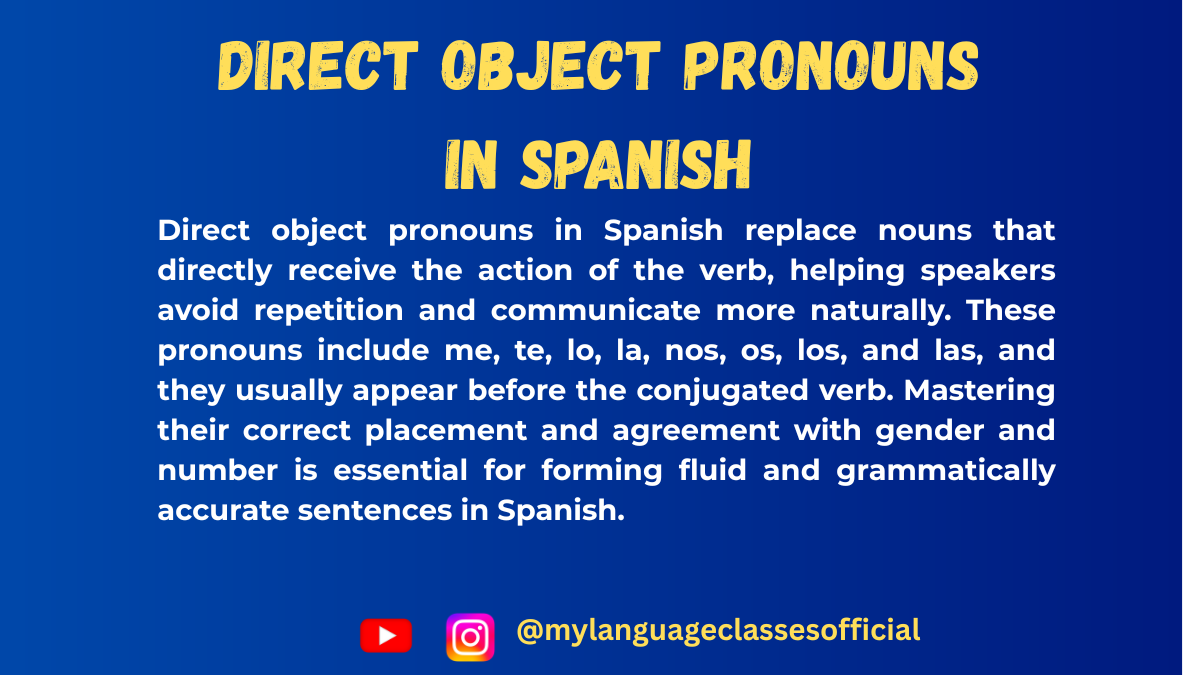Your cart is currently empty!
Direct Object Pronouns in Spanish

Mastering Direct Object Pronouns in Spanish
When learning Spanish, one of the most essential skills is understanding how to use direct object pronouns. These little words can simplify your sentences and make your speech sound more fluid and natural. In this blog, we’ll explore what direct object pronouns are, how they’re used, and provide plenty of examples to help you master them.
What Are Direct Object Pronouns?
A direct object in a sentence answers the questions “what?” or “whom?” about the verb. For example:
- I see the book. (What do I see? The book.)
- She calls her friend. (Whom does she call? Her friend.)
In Spanish, instead of repeating the noun (like “the book” or “her friend”), we replace it with a direct object pronoun.
The Direct Object Pronouns in Spanish
Here’s a handy table of direct object pronouns:
| Pronoun | English Meaning |
|---|---|
| Me | Me |
| Te | You (informal) |
| Lo | Him/It (masculine) |
| La | Her/It (feminine) |
| Nos | Us |
| Os | You all (informal, Spain) |
| Los | Them (masculine/mixed) |
| Las | Them (feminine) |
Placement of Direct Object Pronouns
In Spanish, the placement of direct object pronouns can seem tricky at first, but there are clear rules:
- Before a Conjugated Verb
- Example:
- Yo veo el carro. (I see the car.) → Yo lo veo. (I see it.)
- Ella compra las flores. (She buys the flowers.) → Ella las compra. (She buys them.)
- Example:
- Attached to an Infinitive
- Example:
- Voy a llamar a María. (I am going to call María.) → Voy a llamarla. (I am going to call her.)
- Example:
- Attached to a Present Participle
- Example:
- Estoy leyendo el libro. (I am reading the book.) → Estoy leyéndolo. (I am reading it.)
- Note: Add an accent to maintain proper stress when attaching the pronoun.
- Example:
- Attached to an Affirmative Command
- Example:
- Compra el pan. (Buy the bread.) → Cómpralo. (Buy it.)
- Note: Add an accent when necessary to preserve the original stress.
- Example:
Examples in Action
Here are some real-life scenarios where direct object pronouns are used:
Simple Sentences
- ¿Tienes el dinero? (Do you have the money?)
→ Sí, lo tengo. (Yes, I have it.) - ¿Conoces a Ana? (Do you know Ana?)
→ Sí, la conozco. (Yes, I know her.)
Questions and Negatives
- ¿Estás mirando la televisión? (Are you watching the TV?)
→ No, no la estoy mirando. (No, I’m not watching it.)
Infinitives
- ¿Vas a ver la película? (Are you going to watch the movie?)
→ Sí, voy a verla. (Yes, I’m going to watch it.)
Commands
- Escribe la carta. (Write the letter.)
→ Escríbela. (Write it.)
Common Errors to Avoid
- Confusing Direct and Indirect Object Pronouns
Remember, direct object pronouns answer “what?” or “whom?”, while indirect object pronouns answer “to whom?” or “for whom?”Example:- Direct: Lo veo. (I see him.)
- Indirect: Le hablo. (I speak to him.)
- Forgetting to Match Gender and Number
Make sure the pronoun matches the noun in gender and number. For example:- Las cartas (the letters) → las
- El carro (the car) → lo
- Misplacing Pronouns
Incorrect: Voy llamarla.
Correct: Voy a llamarla or La voy a llamar.
Practice Time!
Let’s put your skills to the test. Try replacing the direct object with a pronoun in the following sentences:
- Yo compro las manzanas.
- Nosotros vemos a Juan.
- María está leyendo el libro.
- ¿Has visto a tus amigos?
- Compra los billetes.
Answers
- Yo las compro.
- Nosotros lo vemos.
- María está leyéndolo.
- ¿Los has visto?
- Cómpralos.
Final Thoughts
Direct object pronouns are a powerful tool to make your Spanish more efficient and natural. With practice, using them will become second nature. Start incorporating them into your conversations today—you’ve got this!
Keep practicing, and soon you’ll sound like a native! 😊
If you found this guide helpful, I’d love to hear from you! Share your thoughts in the comments below or connect with me on social media. For more tips, resources, and inspiration, visit my blog at mylanguageclasses.in. Follow on Instagram and subscribe on YouTube
📚 Continue Learning Spanish
Vikas Kumar is a dedicated language educator, content creator, and digital entrepreneur, best known as the co-founder of My Language Classes and The Curious Mind. With a strong focus on helping learners achieve fluency in English, Spanish, and Japanese, he has guided audiences worldwide through a diverse range of resources, including in-depth blog articles, engaging YouTube tutorials, and comprehensive Books.
Through My Language Classes, Vikas has built a thriving multilingual learning platform that serves students, travelers, and professionals eager to master communication skills for personal, academic, and professional success. His expertise extends to exam preparation for internationally recognized certifications such as JLPT, DELE, IELTS, and TOEFL, enabling learners to achieve tangible, career-enhancing results.
As the founder of The Curious Mind, he also explores broader areas of knowledge, including self-help, motivation, modern learning strategies, and thought-provoking insights on life and personal growth. His work blends practical teaching methods with a deep understanding of learner psychology, making complex concepts accessible and engaging.
Driven by a mission to make high-quality education accessible to all, Vikas continues to expand his reach across multiple platforms, including YouTube, blogs, eBooks, and social media communities, inspiring thousands to learn, grow, and embrace lifelong learning.


Leave a Reply